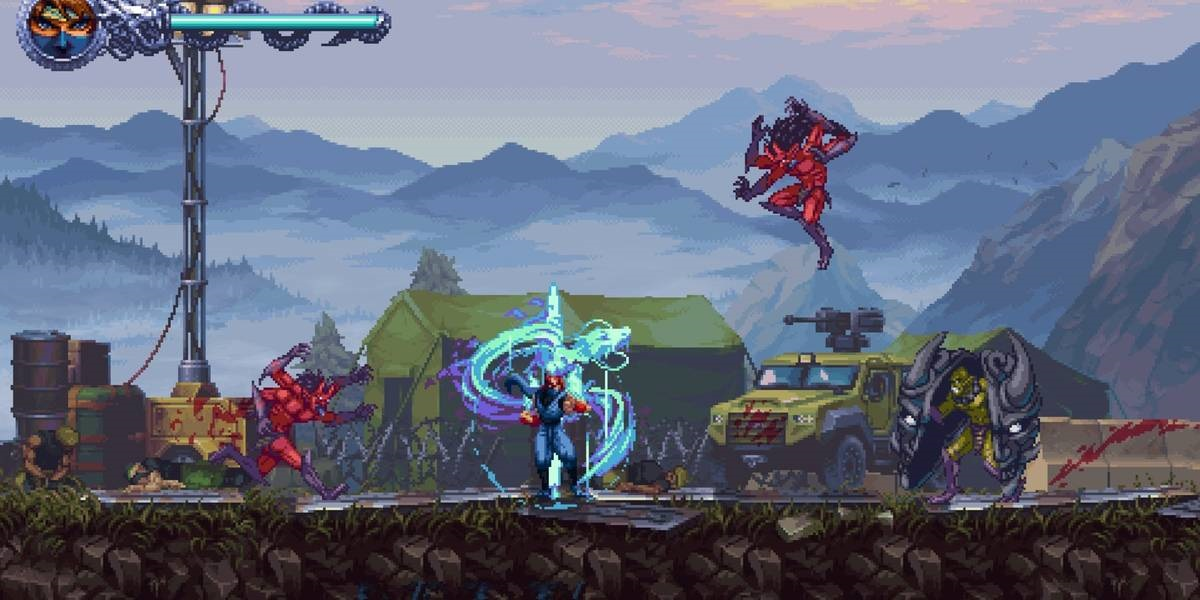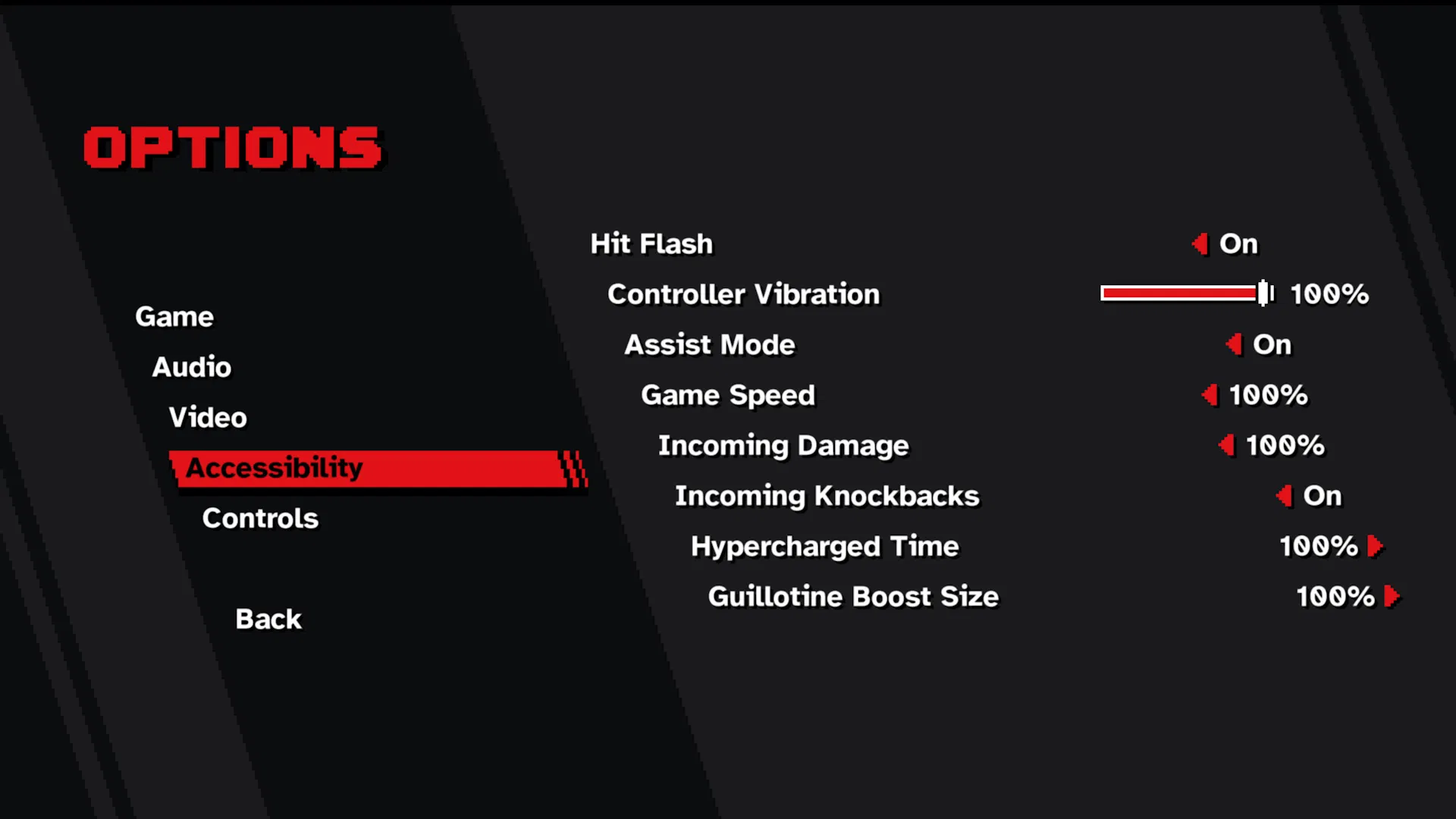It’s been eleven years since we got a new Ninja Gaiden, thirteen since we had one worth mentioning in polite company, and seventeen since there was a new one anyone would call any good. Now we’re getting two in the same year and Ninja Gaiden: Ragebound is first, featuring Ninja Gaiden‘s return to its 2D roots; though not by Tecmo or Team Ninja but instead by The Game Kitchen of Blasphemous fame. With an indie developer and a format the franchise hasn’t been in since 1992, it’s a formula to be a colossal failure or a massive success, with little room in between.
If you’ve played or seen the old NES-era Ninja Gaiden games you’ll have a pretty good idea what to expect from Ragebound: a 2D mix of one-hit kill combat (enemies mostly die in one hit, you have a health bar) and platforming that usually ends in a boss fight. However, unlike the NES Ninja Gaiden, Ragebound isn’t what I would call absurdly difficult thanks to more modernized movement tech and additional considerations like checkpoints and healing orbs/items throughout the levels. This creates a Ninja Gaiden experience that’s a lot more approachable in most respects, assuming you’re okay at platformers, with the majority of the difficulty coming from the final handful of levels, bosses, and some side platforming areas for unlocking secret items. Purists of the classic Ninja Gaiden games have repeatedly said that many of these modern features make the game feel more like the Strider franchise than Ninja Gaiden, but for my money the “gimmicks” that make it Strider-coded for some just seem like a natural interpretation of the early Ninja Gaiden games (mostly). God forbid a franchise evolve with modern ideas like checkpoints, aerial combat, and jumping that doesn’t feel like you need to wait for a frame animation to completely finish before moving again.
Ragebound‘s driving “gimmick” in terms of both gameplay and narrative is that the game’s joint protagonists, Kenji and Kumori, are merged into one body. Kenji, a ninja learning under series-regular Ryu Hayabusa, acts as the traditional “ninja” character that you control through the majority of the game while Kumori, a member of the Black Spiders (the usual antagonists), is a ghost that provides him with magic attacks and occasionally has her own unique platforming challenges. Kumori’s magic attacks are the only ranged abilities in the game and are more powerful than Kenji’s sword, but they are powered by a magic meter of sorts that can only be recharged with Kenji’s own attacks. Since most enemies die in one hit the increased power is rarely a factor outside of bosses, but there is some resource management to consider due to the game’s other major “gimmick”: the Hypercharge Attack. Sold to us in the story as “the most powerful attack you can do at your [ninja] level,” Hypercharge is a super powerful attack that kills anything other than bosses in one strike and is vital for use against the strongest/most frustrating enemies in the game. These harder enemies will block your attacks and/or hit you incredibly hard while taking around six or so attacks to kill, making the Hypercharge the ideal way to get through them in a game all about constant forward momentum.

But how to get a Hypercharge? As you play through levels there will be enemies that glow a certain color, and killing them gives you a Hypercharge for a few seconds. This combined with the stronger enemies that “need” to be killed with a Hypercharge means Ragebound has a very interesting level of foreshadowing in its enemy encounters. If you see a glowing enemy without any large foes nearby it’s likely one of the more durable enemies will be just ahead of you, and if you see a large enemy without any glowing minions then your first target should show itself soon after, usually jumping in from off-screen to be cut down while the big bad waits their turn. The catch here is that once Kenji and Kumori merge the game starts to get tricky with the glowing enemies and only rewards Hypercharge if you kill the glowing enemies a certain way: blue glow means Kenji’s sword and pink glow means with Kumori’s attacks, and quickly navigating between the two can be the difference between rapidly tearing through multiple armored targets or awkwardly standing still and charging up a Hypercharge attack personally (it costs a bit of health but can be done if you’re stuck). The major hiccup here, outside of obvious skill issues where you completely miss which attack to use on which target, is that Kumori’s ranged attacks are based on the aforementioned magic meter so you may not have her attacks ready to go when the pink glowing enemies show up for you to kill. This is especially a problem when the final levels introduce a few enemies that can take multiple hits to kill, so if you’re low on magic juice and a basic stronger enemy with a pink glow shows up you may not have enough energy to accurately kill it. This in and of itself is another form of skill issue, but seems like an unnecessary hurdle to clear in a game where every enemy until that particular point in the game died in one hit.
Outside of people complaining about gimmicks and occasional issues with your ranged attacks being a limited resource, the biggest problem with Ragebound appears to be its technical issues. The platforming itself works well enough and in a few instances is the best flowing platforming I’ve played in years, but occasionally Kenji will decide he doesn’t want to grab the underside of a platform or Kumori will just stop being able to do ranged attacks for a few seconds. This inevitably leads to frustration, damage, and death, usually in that order, and at least in my case a lot of internal doubt about whether or not I fully understood the controls, which isn’t really what you want in a platformer. This is the least of the glitches though, as many people have experienced crashes when trying to skip cutscenes, instant death for skipping cutscenes, death/health loss out of nowhere, achievements breaking, and a few other issues. I experienced none of these personally except the cutscene skip glitch but it’s important to note that the game is not the most technically stable thing in the world.

Slipping into my own personal bias for a moment I do have some issues with a few of the game mechanics, specifically dodging and enemy attacks. Ragebound comes from the old school 2D logic for enemies hurting you where if you touch an enemy you’re dealt damage, and like with so many other old games with the same mechanic it gets really damn frustrating when it happens to your melee-focused character. The bosses in particular are a huge pain for this because most of them are huge and your dodge move won’t get you through their entire body. So you do a dramatic dodge to try to get behind/around the boss and before your i-frames end you’ll only be three-quarters of the way through the monster’s bulk and take damage for no reason. The intent here appears to be to encourage you to use Ragebound‘s “Guillotine Boost” jumping attack to get over these bosses instead, but it’s disappointing that dodging isn’t a bigger part of the experience outside of moving through the smaller traps. It doesn’t help either that Ragebound‘s upcoming “competitor” Shinobi: Art of Vengeance not only doesn’t hurt you when you touch enemies but actively makes dodging part of the combat with a very flashy “dodge through the enemies” animation and mechanic. But I’m getting ahead of myself.
Equally frustrating and even more of my own personal bias is the lack of Ryu Hayabusa in this Ninja Gaiden game. Ragebound takes place parallel to the events of the original Ninja Gaiden to easily explain Ryu’s absence (he was off avenging the death of his father), but I was really hoping to get a bonus level playing as him or skin with his modern look. Hell, they could have had a bonus “Ryu mode” for beating the game on hard where you play as Ryu with just a permanent Hypercharge and infinite projectile magic so that he solos the whole game himself. But no, instead unlocks are just skins for Kenji and Kumori that reference Ryu’s original blue look (which is fine and expected) and shockingly some references to DOA characters too. It doesn’t take anything away from the game that you don’t ever actually control Ryu, but it would have been nice to get something more than just a “classic costume” out of beating the game, especially on hard which does NOT mess around.
Aside from the irregular technical issues, minor grievances with the magic meter system, and my fanboy disappointment that Ryu Hayabusa doesn’t end up playing a bigger role in a game that’s not about Ryu Hayabusa, Ninja Gaiden: Ragebound is a treat and the best non-remaster/remake Ninja Gaiden game in seventeen years. The music is great, the platforming feels great, the action flows very well, and the accessibility toggles means it’s a Ninja Gaiden game everyone can enjoy. I think the main point of contention will be if you find relatively shallow (albeit fast-paced) combat to be a detriment, what with Ragebound‘s one-hit kills and old-school mentality not giving players much in the way of “combos.” The “bad ass ninja” factor is slightly lacking at times in Ragebound because of this and a game like Shinobi: Art of Vengeance has that in spades, so that might be more up ones alley if they feel the need to only play one of them. But again, I’m getting ahead of myself.

